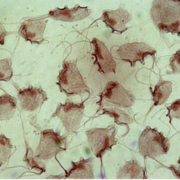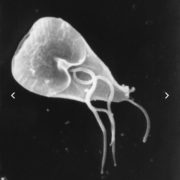Understanding GIARDIA in your new French Bulldog Puppy
Giardia is a waterborne disease found almost everywhere in the world. Giardia disease is caused by a microscopic parasite that is generally attributed to poor sanitation and unsafe water. Giardia infection which is called Giardia is one of the most common causes of waterborne disease in the United States. These parasites are found in back country streams and lakes but also they may be found in municipal water supplies, swimming pools, whirlpools spas and water wells. Giardia affects humans, dogs, cats and other animals. It spreads by food and water that has been contaminated by the Giardia intestinalis, protozoa organism.
Giardia is one of the most common intestinal parasites in the world infecting as much as 20% of the whole population of the earth. It is most common in over crowded developing countries with poor sanitation and a lack of clean water. Giardia is becoming a problem in the United States as well where it affects three times more children than adults. Children can easily pass on the infection by touching
- contaminated toys
- changing tables
- utensils
- their own feces
and then touching other children or people. For this reason, infection travels quickly through a daycare center or an institution for the developmentally disabled. In canine kennels, giardia outbreaks are very common due to water being shared on common grounds that have been contaminated in group situations of many animals together. And as with children, feces and of course dogs that are sniffing each other’s behinds, you can see how this would spread it rapidly if it is a contagious condition which unfortunately Giardia is. Feces contains cysts that are ingested by a human or another animal albeit even microscopically, they are broken down by the stomach acids and the cysts dissolve releasing the active parasite into the body. Once within the body, the parasites cling onto the lining of the small intestine where they reproduce and are swept into the fecal stream or digestive tract. As the liquid content of the bowel dries up the parasite forms cysts which are then passed in the feces. Once excreted the cysts can survive in water for up to three months. When an animal such as a cat or a dog is infected with the giardia parasite the clinical signs of such an infection present with feces that are looking like diarrhea: soft and watery containing blood and or slimy matter, a sort of mucus covering the Poop and having a very foul odor.
So what can we do about it? Traditionally a puppy shows signs of diarrhea after having not changed any eating habits. Here it can sometimes be confusing when the dog has just been newly relocated to its new home. Because stress can also cause varied symptoms of diarrhea type poop. Only after about one week in the puppies new home if the bad poops are getting worse and not better after feeding things like chicken and rice and pumpkin then we should consider that perhaps the puppy has contracted Giardia. In my kennel, my dogs are all treated before they leave my home as if they have Giardia. I am treating with a very powerful medication called SECNIDAZOLE.
Typically, for or a very long time veterinarians have been treating this infection with an ANTIBIOTIC in combination with a DeWORMER. The antibiotic used is “metronidazole” and the dewormer is called “Panacur“. For a very long time, it has been found that the combination of these two ingredients can attack the organ rendering it dead after six days of treatments that occur twice a day. After a weeks break from this medication usually the treatment is done again for six days. Consider though that treating twice a day with two medications over a period of six days equals the administration of 24 different things. Two in the morning and two in the night that’s 4 a day times six equals 24. Most often it is necessary to take a small break and then repeat again another 24 doses.
It seems that then still sometimes it doesn’t work. Animals are being found to still have live cysts three weeks later. This has been referred to as a resistant giardia. It’s really as if the bug has gotten smart and can resist the poison that we are feeding it.You may have heard about antibiotic resistance? This is the same idea. So other alternative solutions have been looked into and the discovery of SECNIDAZOLE has been discovered. I learned about it through doing my own research on the Internet and found this video posted above where the vet is talking to other vets about this medication that is tremendously effective because it does its job in just one single dose to a cat and three doses to a dog. Compare now 24 doses with 3 doses for your dog.
Which would you prefer?
I’m guessing the reason most veterinarians are still not handing out this medication because it is rather costly. However, if you’re reading this article and you watch this video above and are then intrigued then you can request it from your veterinarian. In my experience, it is vastly more effective than the traditional treatment of metronidazole and Panacur. I hope that this will put you on the right track and soon you will have conquered this bugger of a parasite and know to0 that once your puppy reaches the age of approximately eight months he will have built a tolerance to the symptoms and will typically no longer exhibit signs.
It should be noted though that many adult dogs can be carriers of Giardia and because they’re adults and they are tolerant they don’t show the signs which is, of course, one of the issues around the spreading of it because puppies can go to a dog park or a home with other grown dogs and actually catch it from their new playmates. If this is your scenario with other adults dogs in the household it is best to treat all dogs as if infected otherwise your puppy will keep getting infected over and over again.
But in the end, it’s not life-threatening and you will get through this terribly annoying infection and often just understand what you’re dealing with help to calm the nerves that are caused by things we don’t understand. I am always available for conversation so if you have questions you may call me directly on the phone 310-666-7840 or you can text me and I’m happy to look at pictures of your dog’s poop. You may “LOL” but this happens on a weekly basis and I’m happy to be of service.

